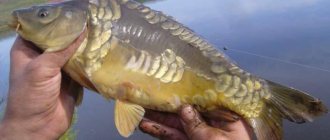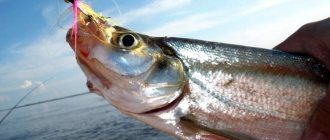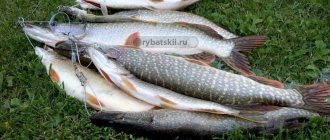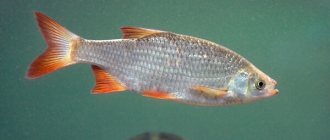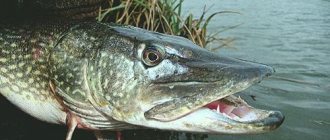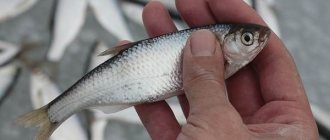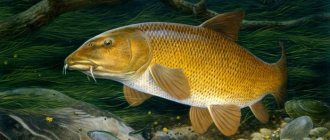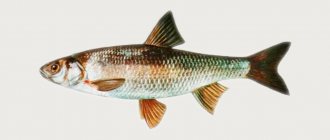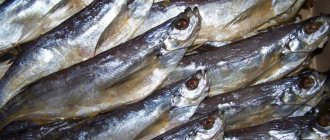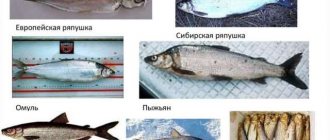Marine life is of interest to many people. Some people admire the beauty of the underwater world and spend a lot of time and effort on scuba diving. Others appreciate moments alone with a fishing rod and rejoice at an unusual or rich catch. And there is a category of people for whom fish is of exclusively gastronomic interest. They value only its nutritional qualities.
This article will talk about an amazing fish that is of great interest to anglers, divers and gourmets? Bright color, interesting habits and unusual taste - all this can be said about a creature called the Black Sea mullet.
Red mullet or sultana?
The fish, which is commonly called red mullet, belongs to the red mullet family. Literally, its name can be translated as “big beard,” which is explained by the presence of prominent mustaches on the head of the sea creature. By the way, it also has another name - ordinary plum. This is what the Turks called the fish. And for good reason. Red mullet is so unusual and tasty that in ancient times the common man did not have the opportunity to taste it. For such an act he faced serious punishment, including deprivation of his head. The entire catch was destined for the Sultan's table. Hence the unofficial name. By the way, you can see what red mullet fish looks like in the photos presented in this article.
Description of striped mullet
The body length of an adult red mullet is 20-25 centimeters, but some individuals grow up to 40 centimeters and have a body weight of 1 kilogram.
Moreover, females are slightly larger than males. The body shape is elongated, the torso is compressed at the sides. The dorsal and anal fins are short, and the caudal fin is forked.
Striped mullet (Mullus surmuletus).
The head of the striped mullet is large, large eyes sit high. The snout drops steeply downwards. The mouth is small. Externally, red mullets are very similar to their closest relatives - common plumes, but the difference is observed in color.
On the sides of the striped mullet's body there are yellow-brown and reddish longitudinal stripes, and in the lower part of the body there are transverse stripes. The belly color is silvery-white. The first dorsal fin is decorated with silvery-white stripes.
The striped mullet has very long mustaches, which is how the fish got its name, since the Latin word for “antennae” is “barbus.” The whiskers are longer than the pectoral fins.
The mullet's whiskers contain taste and tactile cells; with their help, fish find prey at the bottom.
How to identify red mullet?
The appearance of the fish with an unusual name distinguishes it from other inhabitants of the seas. It is small in size, reaching a maximum length of 30 centimeters. The creature's body is oblong, slightly compressed from the sides. The red mullet is distinguished by its color: the back and sides are painted in pink-red shades, and the belly is light yellow. The sea dweller has an amazing feature: after the sultana dies, it changes color. Immediately after catching, the red mullet fish becomes bright red; after 4-8 hours its color fades.
Another distinctive feature of the fish is the presence of long antennae. They help her find food at the bottom of reservoirs, among sand and shells. At the same time, the fish violently releases air bubbles, which is why they got their name - red mullet. Photos of these amazing creatures show us their simple but very cute appearance.
Nutritional value and calorie content
Red mullet meat has high nutritional properties. Nutritional value is determined by the balance of proteins, fats, and carbohydrates. It varies depending on the cooking method:
| Product | Kcal per 100 g | Proteins per 100 g | Fats per 100 g | Carbohydrates |
| Raw red mullet | 117 | 19,4 | 3,8 | 0,0 |
| Smoked | 126 | 21,3 | 4,1 | 0,0 |
| Fried | 144,5 | 24,8 | 4,8 | 0,0 |
The composition changes due to the saturation of the product with fats and spices during frying and changes in the water balance.
Where can you find red mullet fish?
The habitat of fish of the mullet family is the Mediterranean Sea. And also those salty reservoirs that are adjacent to it: Black and Azov. Mullet fish are bottom-dwelling fish. The easiest way to find them is close to the shore. They move in flocks and hide in rocks, looking for food in the sand and shells. The Black Sea red mullet chooses the coastal strips of Crimea. She prefers to live in the area of Balaklava, Chersonesus, Fiolent and Tarkhankut. Experienced fishermen also talk about a large number of these creatures in the Kerch Strait. But the Sultans bypass the Taganrog Bay.
Habitat of the striped mullet
These fish live in the northeastern Atlantic Ocean, ranging from southern Norway to the British Isles. In addition, mullet are common in the Black and Mediterranean Seas, and sometimes swim into the Skagerrak Strait and the North Sea.
Striped mullet live near the bottom, staying at a depth of 5-90 meters, but in the eastern Ionian Sea they are recorded at a depth of 300-400 meters. Red mullet prefer rocky bottoms, but can also live on muddy or sandy bottoms.
Features of behavior
The common sultana, in addition to its bright appearance, is distinguished by its characteristic behavior. This makes it an object of search for both experienced divers and lovers of observing the underwater world. If you find a fish in the rocks and catch it searching for and eating food, you can watch it endlessly. The Black Sea red mullet is not shy. You can get closer to it if you move slowly and without sudden movements. Looking for food for themselves, mullet move along the very bottom, leaving characteristic whisker grooves in the sand. It is these traces that help experienced divers find places where plumes gather.
If you take a worm with you and carefully offer it to the mullet you find, you can watch how they immediately deal with it. An amazing feature of this fish, which is noted by avid fishermen, is the presence of a special smell. Incredibly, the caught red mullet smells not of a specific smell, but of... cucumbers! Another fish, smelt, has this feature, and in a more pronounced form. So if you are lucky enough to catch a sultana, be sure to sniff it - to complete the impression.
Adaptation to modern times
One of the distinctive features of red mullet behavior is their strong reaction to water pollution. Any manifestations of human activity cannot but affect the condition of adjacent water bodies, and especially coastal waters. The development of maritime transport and the annual increase in the resort area with a large number of hotels are fully reflected in the natural conditions. Every year, human activity significantly affects the pollution of coastal waters, which red mullet loves so much. Black Sea waters are no exception. Fish are found in fewer and fewer numbers in their usual places.
This is one of the reasons that single fishermen practically do not hunt for red mullet. The catch is carried out only with nets on an industrial scale.
Nice to see
For those who like to contemplate the beauty of the underwater world, watching red mullets is a real pleasure. This fish is not inferior in color and appearance to the exotic inhabitants of the Red Sea. And her behavior touches every diver. It is best to observe mullet in scuba gear, as these fish prefer a bottom lifestyle and a fairly large depth. Finding a sultana who is looking for food is not difficult. She moves between clusters of sea stones, from island to island. It searches for food with the help of its whiskers, swarming with them in the bottom sand. It is these processes that leave a mark in the form of a furrow, which can reach a length of up to 15 meters. The vigilance of red mullet can be so weakened that it can be caught with bare hands.
Description of species
Red mullet is a type of small fish. In appearance it is similar to herring or goby. It is part of the barabulev family and is found in the Black, Azov, and Mediterranean seas. Popularly, it has a second name, which is related to how it looks. It sounds like a sultana.
Red mullet fish grows on average up to 20 centimeters, with a maximum length of up to 45 centimeters. Due to its special appearance, it cannot be confused with other varieties of marine life. Distinctive features of the red mullet, what it looks like:
Types of red mullet
There are four main types of this fish. Among them:
All species have a characteristic shape for a given type of fish, which was mentioned above. Varieties can be distinguished by the color of the body, scales and fins.
Distinctive features of the species and their photos
Let's look at a photo of a red mullet and the distinctive features of the subspecies by which they can be distinguished.
The Argentine Sultana is a fish with radiant fins. Lives in Brazil and Northern Argentina. Has a characteristic body shape for a sultana. Distinctive features among other species are the red back, which turns into a pink belly and red-yellow fins.
Golden mullet is found in the waters of the Indo-Pacific region. Another name sounds like, toothy sultana. Description – yellow-gray body with blue scales.
The common red mullet has two subspecies – European and Black Sea red mullet. Looks almost the same. It lives on the Atlantic coast, as well as in the Black, Azov and Mediterranean seas. You can also distinguish it using colors. The body has an uneven red color, the belly has silver splashes, and the fins have a yellow tint.
The striped red mullet is found in the Mediterranean and Black Seas. The Mediterranean plume differs from other species not only in color, but also in its gently sloping snout, as well as longitudinal stripes of red, yellow and brown.
Fishing or catching?
The Black Sea mullet has always been of great interest to fishermen. Not every angler knows how to catch it correctly. First of all, you need to know that you need to hunt for the sultana only when the water warms up enough. This period usually begins after mid-May and lasts until the end of September. Time also matters. It is optimal to start fishing no later than 4-5 am. After 9, going out and waiting for the Black Sea mullet to bite makes no sense.
Considering that these fish prefer to hide and move along the very bottom, you need to choose a bottom or float fishing rod. Various baits are suitable for red mullet. But the most delicious for the Sultan will be sea worms. Having put one of them on a fishing rod, you need to leave it at the very bottom or in the sand, expecting the creature to appear there in search of food. If you start fishing in May-early June, then you don’t have to worry about choosing bait at all. It is enough to dig up earthworms - the red mullet will devour everything with appetite. At this time, the Sultan is indiscriminate in food due to severe hunger, so she eats almost everything.
Fishing for red mullet
Those fishermen who go fishing in the Black Sea and the Crimean coast have caught such fish more than once. Any novice angler can cope with its fishing. Red mullet, as a nutritious and tasty fish, is in great demand. For fishing, various gear and devices, as well as simple fishing rods, are used. You can even catch it from the shore.
The lifespan of such fish is from 10 to 15 years. Experienced fishermen know that it is located far or close relative to the shore, depending on the time of year. Adult specimens of the sultana are located near the coast almost all year round, so it is not difficult to catch them. Only in winter do they sail into the depths of the sea.
Fishing takes place using the meat of shrimp, crab, mussels, sea worms and ordinary worms. In addition, the fish are fed. Mussels are suitable for such purposes.
Advice! Sultana can be caught exclusively with fresh bait. She doesn’t bite on an artificial dummy!
How to fish on the bottom?
In a situation where the mullet is in no hurry to peck, you can stir it up a little or tease it. To do this, the tackle must be carefully moved along the bottom. This must be done as follows: the bait mounted on the bottom fishing rod is slightly raised, taken a little to the side and lowered again. And so several times in a row. If all other conditions for catching red mullet are met, and the place and time of fishing are chosen correctly, then after such a technique the red mullet will not resist and will definitely bite.
It is worth noting that despite the small timidity of the fish, it is distinguished by considerable caution. This must be remembered when placing bait on a hook. Small in size, it should be stuck into the very edge of the worm so that the mullet does not fall off at the slightest hook. Photos in various specialized literature for anglers show approximate gear that needs to be chosen for catching sultana.
What about the nutritional value?
In former times, it was not without reason that red mullet was reserved only for the sultans. The meat of this fish is very tasty, regardless of the method of preparation. Many gourmets consider red mullet to be the most nutritious of the Black Sea fish. But taste is an individual matter, but facts are an objective thing. And they say the following. Red mullet meat is considered dietary: this fish is not too fatty, but at the same time quite nutritious.
By supplementing your diet with red mullet, you can compensate for the lack of polyunsaturated fatty acids, Omega-3 and protein. In addition, sultana meat contains a large set of extremely important microelements and vitamins. Among them are iron, magnesium, phosphorus, iodine; vitamins A, E, B1, B9. Fishermen value red mullet for its exceptionally rich and tasty fish. Sultanka is also baked, fried, boiled and smoked. Smoked and salted red mullet tastes similar to roach. In addition, canned fish and even stew are very popular. Although not in all grocery stores, you can find a similar product.
The Black Sea red mullet or red mullet is a sea fish that is amazing in its properties. It lives in accessible regions of the Black and Azov Seas. This means that meeting her, if desired, will not be difficult. Red mullet can interest everyone - lovers of underwater observation, avid fishermen, and connoisseurs of tasty and healthy food.
Origin of the species and description
Photo: Barabulka
In addition to two long mustaches, a characteristic feature of this species is its specific color. The belly of the red mullet is painted in light yellow tones, but the scales covering the sides and back have a pink tint. Another characteristic feature of the species is the acquisition of a bright red color on all sides immediately after catching. Blanching occurs only after 4-5 hours, so this fish is smoked, as they say, “without leaving the cash register” in order to preserve its “marketable appearance.” Red mullet that is put out for sale and has a pale color is considered unfit for consumption (because it was cooked stale).
Video: Red mullet
Interesting fact: Some enthusiastic divers (not spearfishing) spend a lot of time trying to attract fish. They can detect this fish only by whisker marks on the bottom - the original color provides it with excellent camouflage. At the same time, the fish is not particularly timid, so even when detected, it does not swim away from scuba divers. Many of them manage to attract the sultana by offering her a treat in the form of pieces of a worm. She will never object to such a delicacy!
But not only oceanographers are interested in red mullet - this fish is also respected for its gastronomic qualities, it has an amazing taste. This type of fish is loved for its excellent taste. At the same time, red mullet is considered a very useful product. Its meat contains about 20 grams of protein - calculated per 100 grams of weight. But the content of healthy fat in it is low (we mean polyunsaturated fatty acids). Per 100 g of product - no more than 4 g of fat. Important information for those who want to lose weight: red mullet is distinguished by its low calorie content, so it makes sense for those who want to lose weight to pay attention to the seafood delicacy.
Red mullet is the best option as the first fish included in the diet of babies - it can be safely given at 9-10 months. There is information that consumption of this fish has a positive effect on the skin of children. It is also recommended to consume mullet for athletes and people suffering from heart disease - it allows you to quickly restore strength after intense physical activity. But this fish is strongly not recommended for allergy sufferers.
